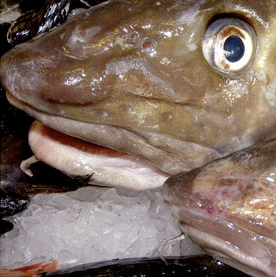 By Tiffany Stecker and Climatewire
By Tiffany Stecker and Climatewire
January 18, 2011 Atlantic cod is yet another species being threatened by climate change. According to a study published Monday in the Proceedings of the National Academy of Sciences, warmer summer waters off the Norwegian coast are dwarfing the growth of the fish. The researchers culled data from surveys dating back to 1919 along the Norwegian coast of the Skagerrak, a triangle of water between Norway, Sweden and Denmark. Over 91 years, ecologists had carefully measured and recorded the sizes of Atlantic cod (Gadus morhua) in the fall. Lauren Rogers, a researcher at the University of Washington and lead researcher for the study, compared these records with data on seasonal temperatures, year by year. In times when summer temperatures peaked, researchers found juvenile cod — born in late winter — to be smaller than usual. The research team found a 3.1 percent decrease in length for every 2-degree-Celsius increase in summer temperatures. The study also showed that warmer springs actually encouraged the growth of juvenile cod, showing an equivalent increase in size for warm springs to the decrease in size for warm summers, given the same 2-degree jump. However, the researchers concluded that the negative effects in size due to hotter Scandinavian summers will outweigh the growth in warmer springtime years, if temperatures continue to rise as predicted. This paper challenges three past studies that found that warming summer water temperatures increased cod size in other regions. In general, biologists believe that warmer temperatures at higher latitudes are beneficial to species growth and population size. Populations increase along a bell-shaped curve, said Rogers, peaking at an optimal high temperature — 12 to 15 degrees Celsius for Atlantic cod. The cod in this study, however, were swimming in waters warmer than the optimal range — 15.9 degrees on average — which is why the results don’t fit in with previous findings. “In general, body size is a very important trait, often linked to a change in survival rates, reproduction and population growth rate,” said Rogers. Big fish off a small coast protect themselves better from predators. …
Warming Waters Further Imperil Atlantic Cod
By Tiffany Stecker and Climatewire